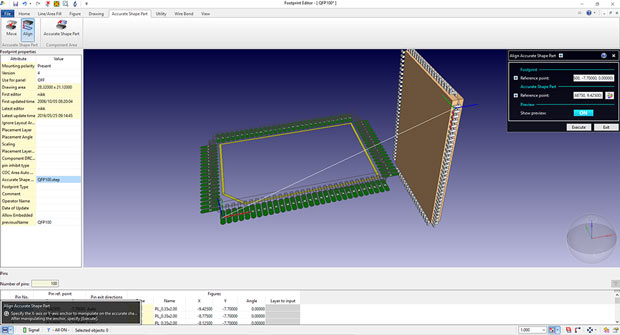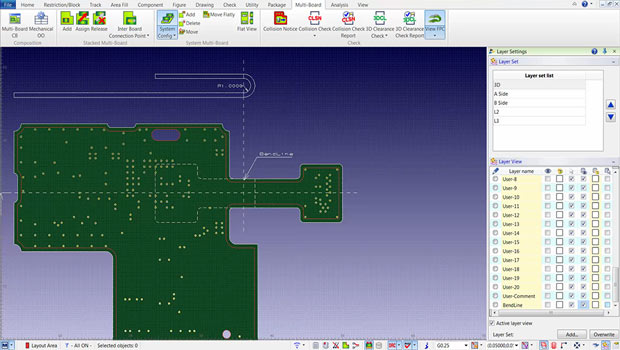Latest News
June 15, 2016
Zuken has announced the 2016 edition of its 3D product-centric PCB (printed circuit board) design software CR-8000. Major enhancements in this release cited by the company include concurrent multi-area PCB design, modular circuit design improvements, a better part swap capability, design analysis upgrades and other 3D design enhancements for more efficient ECAD/MCAD task management and design re-use.
CR-8000’s new concurrent multi-area PCB design capability enables engineering teams to work on and modify the same design area simultaneously. This capability, says Zuken, can reduce overall design time as well as make the best use of globally dispersed teams. With the multi-area concurrent design capability, individual engineers control their own viewpoint and have continual, instantaneous visibility of the design as well as any remaining unconnected nets. Performance improvements in both the client and server offer design speeds of up to 17 times faster than earlier releases, adds Zuken.
 CR-8000’s new concurrent multi-area PCB design capability enables engineering teams to work on and modify the same design area such as this ground structure simultaneously. Image courtesy of Zuken.
CR-8000’s new concurrent multi-area PCB design capability enables engineering teams to work on and modify the same design area such as this ground structure simultaneously. Image courtesy of Zuken.New search and re-use capabilities for modular circuit block selection are introduced in CR-8000 version 2016. Designers can add module attributes to a block for characterization, which, explains Zuken, can result in a faster and more efficient selection process. Building on CR-8000’s existing constraint re-use functionality, constraint arbitration in version 2016 now allows engineers to view a section of the block and see conflicting constraints. Additionally, designers can now define which information to preserve within a design by constraint or object.
Zuken reports that design effort has been reduced dramatically with improvements to CR-8000’s part swap capability introduced in the 2016 edition. Designers can now view superseded or highlighted parts directly within the circuit data and make changes collectively. This, explains the company, avoids time-consuming manual checks for part swaps and enables designers to start at any point, swapping out obsolete parts as the design progresses without being concerned about missing an instance of a superseded part.
 Beginning with the 2016 release of CR-8000 PCB designers can view superseded or highlighted parts directly within the circuit data and make changes collectively. Image courtesy of Zuken.
Beginning with the 2016 release of CR-8000 PCB designers can view superseded or highlighted parts directly within the circuit data and make changes collectively. Image courtesy of Zuken.Design analysis improvements include stronger analog simulations through an interface to Linear Technology’s LTspice for SPICE simulation, schematic captures and waveform viewing. Among CR-8000’s new signal integrity (SI) analysis features are package model and algorithmic modeling with IBIS-AMI, frequency domain analysis from the electrical editor and improved S-parameter support with a results display and export capability.
3D ECAD/MCAD efficiencies debuting in CR-8000 include true component shapes, managed origin alignment as well as rigid-flex product visualization and design validation checks. True 3D STEP models are now defined within the library at the component level, including footprint, package, part and instance levels. Once a user selects a component, the 3D model will automatically become part of the PCB design.
 With CR-8000 version 2016, designers can define true component shape references and alignments within the ECAD library. Image courtesy of Zuken.
With CR-8000 version 2016, designers can define true component shape references and alignments within the ECAD library. Image courtesy of Zuken.Managed origin alignment ensures a common reference point between the ECAD and MCAD libraries as well as the alignment of the 3D shape to the component footprint. An accurate 3D component model for output to MCAD is supported, with export of whole or subset designs.
With rigid-flex product visualization and design validation checks, the bend of the flex board can be modeled and collisions viewed to check for design issues with the product modeled to final state condition. This avoids design re-work and iterations between mechanical and electrical design, explains Zuken.
 Zuken says that the new bending flex with collision check capability in the 2016 release of its CR-8000 PCB design software can help avoid design rework and iterations between ECAD/MCAD. Image courtesy of Zuken.
Zuken says that the new bending flex with collision check capability in the 2016 release of its CR-8000 PCB design software can help avoid design rework and iterations between ECAD/MCAD. Image courtesy of Zuken.Version 2016 of CR-8000 also sees performance improvements that enable support for very large pin count devices as well as support for LEF/DEF v 5.8 import/export. Its ODB++ import/export capabilities have been updated, and CR-8000 version 2016 supports the ANSYS Electronic DataBase (EDB) format. Test points can now be allocated automatically at all stages of the design process.
The 2016 release of CR-8000 PCB design software is available now. For more information, click here.
Sign up here to test drive CR-8000 on the cloud.
Watch a video introduction to CR-8000.
Download the white paper “3D Convergence of Multi-board PCB and IC Packaging Design.”
Check out Zuken’s Hardware Architecture Design and Validation Webinar Series.
Sources: Press materials received from the company and additional information gleaned from the company’s website.
Subscribe to our FREE magazine, FREE email newsletters or both!
Latest News
About the Author
Anthony J. Lockwood is Digital Engineering’s founding editor. He is now retired. Contact him via [email protected].
Follow DE





